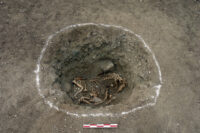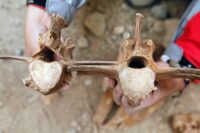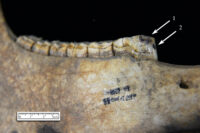 Researchers have discovered the oldest direct evidence of mounted horseback riding in China. Horse burials have shown that the nomadic peoples of the Eurasian Steppes were riding domesticated horses at least as far back as the 18th century B.C., but there has been no equivalent hard archaeological data found in China to indicate when horseback riding was adopted. Analysis of ancient horse bones discovered in Shirenzigou and Xigou in Xinjiang, northwest China, has now revealed that people in the area were riding horses by 350 B.C., predating the Silk Road trade through the region.
Researchers have discovered the oldest direct evidence of mounted horseback riding in China. Horse burials have shown that the nomadic peoples of the Eurasian Steppes were riding domesticated horses at least as far back as the 18th century B.C., but there has been no equivalent hard archaeological data found in China to indicate when horseback riding was adopted. Analysis of ancient horse bones discovered in Shirenzigou and Xigou in Xinjiang, northwest China, has now revealed that people in the area were riding horses by 350 B.C., predating the Silk Road trade through the region.
The skeletons of eight horses from the Late Warring States period were unearthed in nearly complete condition, which made a thorough osteological examination possible. With entire bodies to examine, researchers were able to establish patterns of stress typical of horseback riding seen at other archaeological sites and in modern veterinary practice.
 Analysis of vertebrae found pathologies like excessive bone growth and fractures in 60% of the 240 vertebrae examined. They were concentrated in the bones of the lower back which is where horses bear the most stress from carrying riders.
Analysis of vertebrae found pathologies like excessive bone growth and fractures in 60% of the 240 vertebrae examined. They were concentrated in the bones of the lower back which is where horses bear the most stress from carrying riders.
The skulls of six of the horses were found to have deep grooves in the nose bones caused by heavy breathing and overdeveloped muscles, evidence the animals were worked hard. The deeper the groove, the more strenuous the exertion over the longest period of time.
Next the teeth were examined. Of the six horses discovered with intact teeth, all of them suffered from abrasions on their lower second premolars. This was the result of contact with an iron bit pulled hard by a rider. If it’s tugged back sharply enough, the bit hits the teeth.
Taken together, these bone and tooth abnormalities are textbook examples of what happens when horses are ridden heavily, said Alan Outram, an archaeologist at the University of Exeter in the United Kingdom, not involved in the research.
“There’s no question that these horses are riding horses,” he said.
“We don’t know how horses went from being an animal that was primarily pulling chariots to one that was engaging in sophisticated cavalry combat,” he said. “Here are some clues to that story.”
 Humans buried at the site confirm the discovery. Femurs of adult males from several burials exhibited curved diaphysis, an abnormality caused by habitual horse riding from a young age, as well as other biomechanical stressors associated with equestrianism. An iron bit was also found, as was a plethora of arrowheads, evidence of mounted archery.
Humans buried at the site confirm the discovery. Femurs of adult males from several burials exhibited curved diaphysis, an abnormality caused by habitual horse riding from a young age, as well as other biomechanical stressors associated with equestrianism. An iron bit was also found, as was a plethora of arrowheads, evidence of mounted archery.
Tracing the emergence of horseback riding is the first step to better understanding how this practice catalyzed crucial changes across China, [University of Colorado Museum of Natural History archaeologist William] Taylor said.
“We don’t know how horses went from being an animal that was primarily pulling chariots to one that was engaging in sophisticated cavalry combat,” he said. “Here are some clues to that story.”